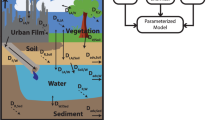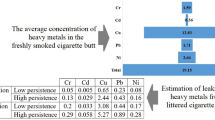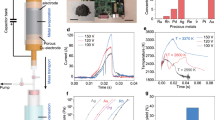Abstract
Urban mines—stockpiles of materials in discarded waste—include various metals, oxides, polymers and halogens with diverse implications in terms of materials sustainability, which are reflected in different environmental–economic–efficiency trade-offs when recycling them. Here we leverage the diverse composition of urban mines to develop ‘reciprocal recycling’—a self-assembly strategy that uses urban mine components to support their own recycling to ultimately activate sustainable urban mining. We screened tens of physicochemical componential interactions available for multimetal co-recovery, halogenated pollutants elimination and polymer conversion. Self-assembly prototypes with four fundamental componential interactions were presented for reciprocal recycling of representative urban mines. Under the guidance of revealed physicochemical interaction mechanisms, the reciprocal recycling process design enabled >96% recovery of copper–platinum–palladium–rhodium, >99% suppression of brominated pollutants and mediated epoxy resin conversion. The self-assembly strategy showcased joint environmental–economic–efficiency benefits and high flexibility, paving the way to sustainable urban mining and improving material circularity.
This is a preview of subscription content, access via your institution
Access options
Access Nature and 54 other Nature Portfolio journals
Get Nature+, our best-value online-access subscription
$32.99 / 30 days
cancel any time
Subscribe to this journal
Receive 12 digital issues and online access to articles
$119.00 per year
only $9.92 per issue
Buy this article
- Purchase on SpringerLink
- Instant access to full article PDF
Prices may be subject to local taxes which are calculated during checkout






Similar content being viewed by others
Data availability
All data are available in the main text or the Supplementary Information. Source data are provided with this paper.
References
Graedel, T. E., Harper, E. M., Nassar, N. T., Nuss, P. & Reck, B. K. Criticality of metals and metalloids. Proc. Natl Acad. Sci. USA 112, 4257–4262 (2015).
Zeng, X., Ali, S. H., Tian, J. & Li, J. Mapping anthropogenic mineral generation in China and its implications for a circular economy. Nat. Commun. 11, 1544 (2020).
Baldé, C. P. et al. The Global E-waste Monitor 2024 (International Telecommunication Union and United Nations Institute for Training and Research, 2024).
Fan, E. et al. Sustainable recycling technology for Li-ion batteries and beyond: challenges and future prospects. Chem. Rev. 120, 7020–7063 (2020).
Heacock, M. et al. E-waste and harm to vulnerable populations: a growing global problem. Environ. Health Perspect. 124, 550–555 (2016).
Vidal, O., Goffé, B. & Arndt, N. Metals for a low-carbon society. Nat. Geosci. 6, 894–896 (2013).
Breivik, K., Armitage, J. M., Wania, F., Sweetman, A. J. & Jones, K. C. Tracking the global distribution of persistent organic pollutants accounting for e-waste exports to developing regions. Environ. Sci. Technol. 50, 798–805 (2016).
Gollakota, A. R. K., Gautam, S. & Shu, C.-M. Inconsistencies of e-waste management in developing nations—facts and plausible solutions. J. Environ. Manag. 261, 110234 (2020).
Zabala, A. Illegal electronic waste recycling trends. Nat. Sustain. 2, 353–354 (2019).
Chen, H. et al. Combined effects of dust and dietary exposure of occupational workers and local residents to short- and medium-chain chlorinated paraffins in a mega e-waste recycling industrial park in South China. Environ. Sci. Technol. 52, 11510–11519 (2018).
Parvez, S. M. et al. Health consequences of exposure to e-waste: an updated systematic review. Lancet Planet. Health 5, e905–e920 (2021).
Bel, G. et al. A New Circular Vision for Electronics, Time for a Global Reboot (Platform for Accelerating the Circular Economy, 2019).
Liang, J. et al. The formation pathways of polybrominated dibenzo-p-dioxins and dibenzofurans (PBDD/Fs) from pyrolysis of polybrominated diphenyl ethers (PBDEs): effects of bromination arrangement and level. J. Hazard. Mater. 399, 123004 (2020).
Tang, H. et al. Recovery of platinum-group metals from spent catalysts by microwave smelting. J. Clean. Prod. 318, 128266 (2021).
Park, Y.-K., Han, T. U., Jeong, J. & Kim, Y.-M. Debrominated high quality oil production by the two-step catalytic pyrolysis of phenolic printed circuit boards (PPCB) using natural clays and HY. J. Hazard. Mater. 367, 50–58 (2019).
Zhang, L., Song, Q., Liu, Y. & Xu, Z. An integrated capture of copper scrap and electrodeposition process to enrich and prepare pure palladium for recycling of spent catalyst from automobile. Waste Manag. 108, 172–182 (2020).
Lou, X. et al. Grave-to-cradle photothermal upcycling of waste polyesters over spent LiCoO2. Nat. Commun. 15, 2730 (2024).
Nuraeni, B. A., Avarmaa, K., Prentice, L. H., Rankin, W. J. & Rhamdhani, M. A. Recovery of cobalt and lithium by carbothermic reduction of LiCoO2 cathode material: a kinetic study. Metall. Mater. Trans. B 54, 602–620 (2023).
Deng, B. et al. Flash separation of metals by electrothermal chlorination. Nat. Chem. Eng. 1, 627–637 (2024).
Cheng, Y. et al. Flash upcycling of waste glass fibre-reinforced plastics to silicon carbide. Nat. Sustain. 7, 452–462 (2024).
Altarawneh, M., Saeed, A., Al-Harahsheh, M. & Dlugogorski, B. Z. Thermal decomposition of brominated flame retardants (BFRs): products and mechanisms. Prog. Energy Combust. Sci. 70, 212–259 (2019).
Terakado, O., Ohhashi, R. & Hirasawa, M. Bromine fixation by metal oxide in pyrolysis of printed circuit board containing brominated flame retardant. J. Anal. Appl. Pyrolysis 103, 216–221 (2013).
Gao, R. et al. In situ debromination mechanism based on self-activation and catalysis of Ca(OH)2 during pyrolysis of waste printed circuit boards. J. Hazard. Mater. 392, 122447 (2020).
Cen, Z. et al. Upcycling of polyethylene to gasoline through a self-supplied hydrogen strategy in a layered self-pillared zeolite. Nat. Chem. 16, 871–880 (2024).
Ma, C., Kumagai, S., Saito, Y., Kameda, T. & Yoshioka, T. Enhanced production of phenol and debromination by co-pyrolysis of the non-metallic fraction of printed circuit boards and waste tires. Green. Chem. 23, 6392–6404 (2021).
Li, T.-Y. et al. Emissions and occupational exposure risk of halogenated flame retardants from primitive recycling of e-waste. Environ. Sci. Technol. 53, 12495–12505 (2019).
Li, S. Y., Sun, S. Y., Liu, J. Y., Wu, J. Q. & Zeng, J. J. Thermal debromination of waste printed circuit boards by iron-based catalyst. Adv. Mater. Res. 881-883, 589–593 (2014).
Smykalla, L., Shukrynau, P., Korb, M., Lang, H. & Hietschold, M. Surface-confined 2D polymerization of a brominated copper-tetraphenylporphyrin on Au(111). Nanoscale 7, 4234–4241 (2015).
Lovell, A., Brezinsky, K. & Glassman, I. The gas phase pyrolysis of phenol. Int. J. Chem. Kinet. 21, 547–560 (1989).
Borojovich, E. J. C. & Aizenshtat, Z. Thermal behavior of brominated and polybrominated compounds II: pyroproducts of brominated phenols as mechanistic tools. J. Anal. Appl. Pyrolysis 63, 129–145 (2002).
Guisbiers, G., Abudukelimu, G. & Hourlier, D. Size-dependent catalytic and melting properties of platinum–palladium nanoparticles. Nanoscale Res. Lett. 6, 396 (2011).
Xiao, J., Li, J. & Xu, Z. Novel approach for in situ recovery of lithium carbonate from spent lithium ion batteries using vacuum metallurgy. Environ. Sci. Technol. 51, 11960–11966 (2017).
Zhang, L. & Xu, Z. C, H, Cl and In element cycle in wastes: vacuum pyrolysis of PVC plastic to recover indium in LCD panels and prepare carbon coating. ACS Sustain. Chem. Eng. 5, 8918–8929 (2017).
Kresse, G. & Joubert, D. From ultrasoft pseudopotentials to the projector augmented-wave method. Phys. Rev. B 59, 1758 (1999).
Perdew, J. P., Burke, K. & Ernzerhof, M. Generalized gradient approximation made simple. Phys. Rev. Lett. 77, 3865 (1996).
Sheppard, D., Xiao, P., Chemelewski, W., Johnson, D. D. & Henkelman, G. A generalized solid-state nudged elastic band method. J. Chem. Phys. 136, 074103 (2012).
Wang, V., Xu, N., Liu, J.-C., Tang, G. & Geng, W.-T. VASPKIT: a user-friendly interface facilitating high-throughput computing and analysis using VASP code. Comput. Phys. Commun. 267, 108033 (2021).
Frisch, M. J. et al. Gaussian 16 revision C.01 (2016).
Acknowledgements
This work was supported by National Natural Science Foundation of China (52170136). We are grateful to Shanghai Super Postdoctoral Incentive Program (2022343), Ningda of Precious Metals and Shanghai Xinjinqiao Environmental Protection. We acknowledge X. Shi, K. Shengnan, G. Yu and D. Xue from Instrumental Analysis Center of Shanghai Jiao Tong University for their technical support and W. Qinmeng and L. Zhongchen from Central South University for FactSage simulation.
Author information
Authors and Affiliations
Contributions
Conceptualization: Z.X., Q.S. Methodology: Q.S., S.C., X.Y., H.S. Investigation: Q.S., S.C. Visualization: Q.S., Y.L. Supervision: Z.X. Writing—original draft: Q.S., H.S. Writing—review and editing: Q.S., H.S., Z.X.
Corresponding author
Ethics declarations
Competing interests
The authors declare no competing interests.
Peer review
Peer review information
Nature Sustainability thanks Jinxing Chen, Qingbin Song and the other, anonymous, reviewer(s) for their contribution to the peer review of this work.
Additional information
Publisher’s note Springer Nature remains neutral with regard to jurisdictional claims in published maps and institutional affiliations.
Extended data
Extended Data Fig. 1 Components self-assembly design for WPCBs and SACs reciprocal recycling.
PCBs are ubiquitous and essential parts in almost all electrical and electronic devices, which consist of copper foil and glass fiber-reinforced epoxy resin (containing brominated flame retardants) with surface-mounted electric components. WPCBs pyrometallurgical recycling requires the enrichment of dispersed metals separated from nonmetal fraction, the suppression of toxic brominates and polyaromatic hydrocarbons (PAHs), and the effective recycling of polymers. Automobile catalysts are indispensable for emission control of automobiles where nanosized PGM particles dispersed on cordierite substrates enable NOx and CO transformation. The typical composition of real WPCBs and SACs used in this study was shown in Extended Data Fig. 1 and Supplementary Fig. 17. According to their composition characteristics, physicochemical properties, and recycling requirements, large-size metals in WPCBs facilitated co-recovery of PGM nanoparticles in SACs during smelting, the oxide components in both wastes constituted optimal slags with supplementary SiO2 and CaO, the elimination of brominated pollutants in WPCBs via coexisting oxides, and the oxide-mediated epoxy resin transformation.
Extended Data Fig. 2 Debromination mechanisms via a gaseous and oxide-mediated radical route.
(a) Pyro-GC/MS analysis of 2-bromophenol with the absence and presence of CaO at 600 °C, helium atmosphere. (b) The gaseous debromination route without CaO. Gibbs free energy change for gaseous molecular reaction was calculated at M06-2X(D3)/Def2tzvp level using Gaussian. For reference, the ΔG from VASP calculation is ~69 kcal/mol. (c) One of the CaO promoted debromination routes through C-Br homolysis with lower Gibbs free energy change compared to the gaseous route.
Supplementary information
Supplementary Information
Supplementary Notes 1–8, Figs. 1–30, Tables 1–14 and Schemes 1–5.
Supplementary Data 1
Computational structure and energy data.
Supplementary Data 2
The calculated data of collision distance, nanoparticle movement distance and settlement velocity for metal–metal interaction analysis.
Source data
Source Data Fig. 3
Statistical source data.
Source Data Fig. 4
Statistical source data.
Source Data Fig. 5
Statistical source data.
Source Data Extended Data Fig. 2
Statistical source data.
Rights and permissions
Springer Nature or its licensor (e.g. a society or other partner) holds exclusive rights to this article under a publishing agreement with the author(s) or other rightsholder(s); author self-archiving of the accepted manuscript version of this article is solely governed by the terms of such publishing agreement and applicable law.
About this article
Cite this article
Song, Q., Chen, S., Yuan, X. et al. Component self-assembly for reciprocal urban mining. Nat Sustain 8, 1026–1036 (2025). https://doi.org/10.1038/s41893-025-01611-y
Received:
Accepted:
Published:
Issue date:
DOI: https://doi.org/10.1038/s41893-025-01611-y



